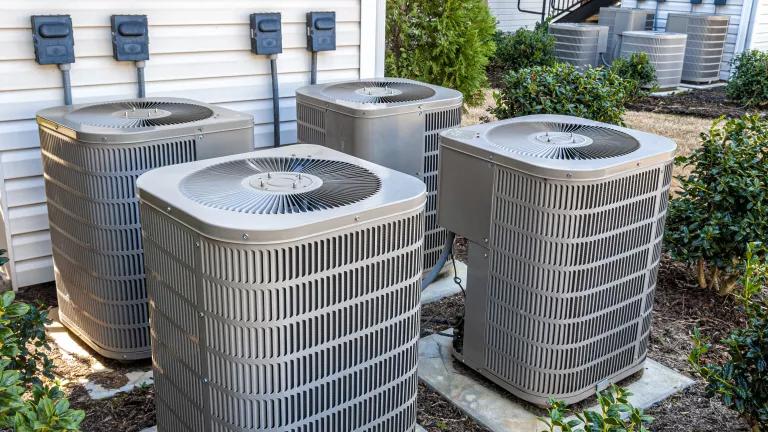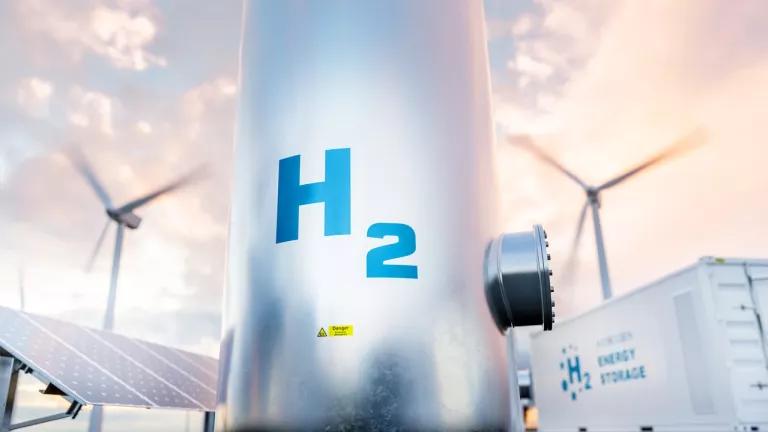AIM Act Allies Press EPA to Move Industries Beyond HFCs
NRDC and other environmental, state, and industry organizations called on the EPA to ban the super climate pollutants called hydrofluorocarbons from key applications where climate-friendlier alternatives are readily available.

Air conditioners today use climate-polluting HFCs.
NRDC and other environmental, state, and industry organizations called on the Environmental Protection Agency today to ban the super climate pollutants called hydrofluorocarbons (HFCs) from key applications where climate-friendlier alternatives are readily available. With five petitions to EPA, these groups have kicked off implementation of the American Innovation and Manufacturing (AIM) Act, a major new climate protection law enacted in December 2020.
HFCs are man-made gases used in air conditioners and heat pumps, refrigerators, insulating foams, aerosol products, and other applications. They pack a mighty climate punch. Pound-for-pound, HFCs warm the climate several thousand times more than carbon dioxide.
The AIM Act requires an 85 percent phasedown in HFC supply over the next 15 years. It will bring the United States into compliance with the 2016 Kigali Amendment to the Montreal Protocol, which provides for a global HFC phasedown. The AIM Act authorizes EPA to adopt related regulations, including the application-specific HFC use bans requested by today’s petitions, to cut HFC leakage in the servicing and disposal of HFC-containing equipment, promote HFC reclamation and reuse, and more.
Building on the momentum from enactment of the AIM Act, the Biden administration has also moved the U.S. toward ratifying the Kigali Amendment. The president’s climate executive order in late January instructed the State Department to prepare a “ratification package” for submission to the Senate for advice and consent. State sent that package to the White House in late March, and we look forward to Senate action later this year.
Today’s petitions tackle some of the largest categories of HFC use: air conditioning, refrigeration systems, and vehicle air conditioners, as well as some additional uses. Taken together, the submittals paint a remarkably harmonious picture of the coming transition away from HFCs, reflecting a productive, ongoing collaboration among environmentalists and industry to move to next-generation technologies.
Here’s how all the petitions fit together:
Reinstating EPA’s First-Round “SNAP” Rules
NRDC, joined by the State of Colorado and the Institute for Governance and Sustainable Development, has asked EPA to reinstate two regulations, “SNAP Rules 20 and 21,” issued in 2015 and 2016, through which the agency had started reducing HFCs. Those rules were blocked, however, when a court held in 2017 that the Clean Air Act did not give EPA the authority to require current users of HFCs to switch to safer alternatives. In the AIM Act, Congress expressly provided the authority the court said was lacking.
The two SNAP rules were designed to eliminate HFCs from car air conditioners, foams, and aerosols, and stop use of the worst-offending HFCs in refrigeration—all applications where safer alternatives are available. Several states in the U.S. Climate Alliance stepped in to partly fill the gap by adopting those rules at the state level. Nine states have versions of these regulations fully in place, with several of the remaining states in the midst of adopting legislation or rules. Now it’s time to reinstate the SNAP rules nationwide.
The Air-conditioning, Heating, and Refrigeration Institute (AHRI)—which represents the major central air conditioning and heat pump manufacturers, among others—also submitted a petition regarding HFC use in a variety of commercial refrigeration applications, some of which were covered by the 2015 and 2016 rules. While not identical, our petition and AHRI’s take a similar view where it counts: that EPA should quickly outlaw use of the most potent HFCs in supermarket systems and other big refrigeration installations, as it did in the SNAP rules. AHRI has also added a few additional categories to its petition, such as transportation refrigeration, (think refrigerated trucks and trailers carrying perishable goods).
Taking California’s Leadership Nationwide
The Environmental Investigation Agency (EIA), joined by NRDC and others, submitted a petition asking EPA to extend nationwide most elements of a new suite of HFC regulations just adopted in California. In December, the California Air Resources Board established these first-of-their-kind HFC limits in air conditioners and heat pumps and strengthened requirements on large new refrigeration systems such as supermarkets to the point of virtually eliminating their climate impact.
The industry group, AHRI, submitted a similar petition seeking to extend California’s regulations on air conditioners and heat pumps nationwide on the same timeline.
Around-the-House Appliances Take Steps, Too
Lastly, the Association of Home Appliance Manufacturers (AHAM), representing the makers of window and portable air conditioners, filed a petition covering its cadre of smaller products, with NRDC’s support. The petition calls for using lower-GWP alternatives between 2023 and 2024 in most smaller air conditioning products and two years after EPA approval of new alternatives for dehumidifiers. It differs in a couple places from similar restrictions in California, particularly the delay until EPA approves alternatives for dehumidifiers, which we find reasonable before embarking on a nation-wide transition.
Here’s how all these petitions fit in to the bigger HFCs picture.
The end-use actions sought by the petitions would supplement the AIM Act’s phasedown of HFC production and import by 85 percent over the next 15 years. The AIM Act requires EPA to issue a regulation by September that formalizes the cap and reduction schedule for the U.S. supply of HFCs and apportions shares of the allowed production and import to various entities. EPA’s proposed allocation rule, as it is known, is currently under review at the Office of Management and Budget and is expected to be published for public comment soon.
Once implemented, the U.S. production phasedown will produce huge benefits, avoiding HFC use in the U.S. by the equivalent of two billion metric tons of CO2 over the 15-year phasedown period. By transitioning HFC end-uses to safer alternatives more quickly, the petitions will help the country meet the AIM Act’s schedule for reducing overall HFC production and import. Indeed, the petitions may enable an even faster ramp down of HFC production, and the AIM Act authorizes EPA to accelerate the production phasedown starting in 2025.
The AIM Act requires EPA to grant or deny today’s petitions within six months. If requests are denied, EPA must give the reasons why. When it approves a petition, EPA has two years to issue a final regulation making the requested changes. NRDC will be staying hot on EPA’s heels as it works through today’s petitions in the formal rulemaking process.
We’re also looking forward to continuing the collaboration we’ve shared with other environmental organizations, industry, and leadership states as we continue down the road of implementing the AIM Act. There’s much work to be done, particularly on issues such as boosting reclamation of HFCs, improving handling and disposal requirements of HFC-containing appliances, and more.






